One of the earliest blooming Spring Ephemeral flowers is Bloodroot, Sanguinaria canadensis. The days are often cold and windy at the time of year when the bloodroot blooms, but once the sun shines long enough to warm the ground bloodroot will emerge.
Bloodroot grows in eastern forests, especially moist soils in wooded areas. The Mill Race Trail at Little Buffalo State Park, Newport, Pennsylvania, is a great place to see this perennial spring flower blooming in early April.
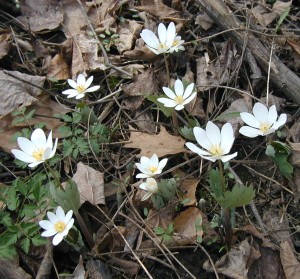
The flowers arise from an underground rhizome in a bud fashion. If you looking for bloodroot on the early side, you might see a few flowers still curled up tight before the blossoms open.
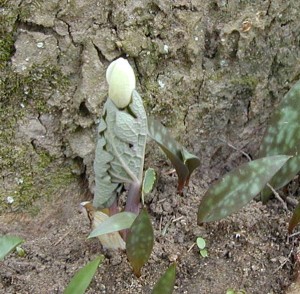
In the image above you can see the leaf curled around the flower stem below the small white flower bud. The sword-like mottled leaves next to the bloodroot are trout lilies that had yet to bloom.
As bloodroot grows the flower stem continues to elongate and the flower opens up. The leaf of bloodroot is still wrapped around the flower stem while the flower is blooming.
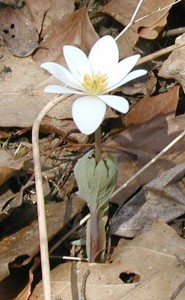
Once the petals of the bloodroot flower start to open you’ll be able to see the large canary yellow stamens.
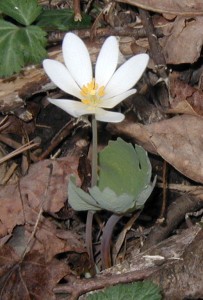
As the bloodroot flower matures the leaf also continues to develop and pull away from the flower stem.
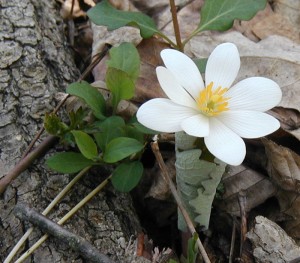
It would be cool to see bloodroot flowers under a UV light – I wonder if the gray lines on the white petals would light up to show the pollinators where to find the pollen. You have to inspect the flower really closely to see these lines, which are barely visible in bright sunlight.
Bloodroot is considered a Spring Ephemeral, flowering only for a brief time in early spring before the trees leaf out. If you get into the woods after the tree leaves emerge, you probably won’t find any bloodroot still blooming.
Bloodroot blooms for about a week, depending on the weather in early Spring. Here in Southcentral PA we see bloodroot the first or second week of April.
Bloodroot flowers have eight to ten, white, elongated petals that seem to be attached rather loosely. Any attempts at picking the flower or digging one up will result in the loss of petals. That’s probably why we don’t see bloodroot at garden centers. They’re too delicate for any handling and would never look good in flower arrangements because of that.
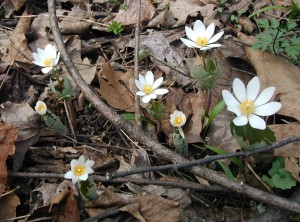
The flowers of bloodroot should be appreciated in their natural habitat or perhaps in a native plants garden.
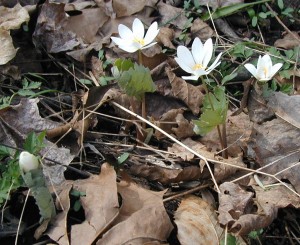
Closer inspection of the flower shows that it comes up first, followed by a single leaf for each flower. The leaves emerge curled around the flower stem. After the flower has bloomed and lost its petals, the leaf will grow in earnest.
The large round leaf of bloodroot is a unique one with a deeply scalloped edge. In the image below there are about 16 bloodroot leaves.
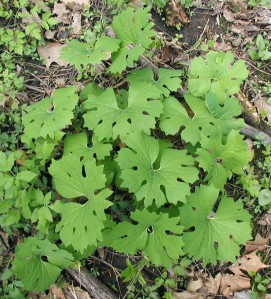
Some of the leaves will get pretty large – as big as your hand, or 8 to 10 inches across. No two leaves seem to have the same exact design, although they all have 7-10 deeply cut lobes each of which are scalloped or have deep, rounded notches.
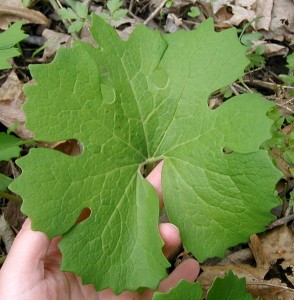
Peeking underneath the leaves you can see the seed pods forming from the old flower.
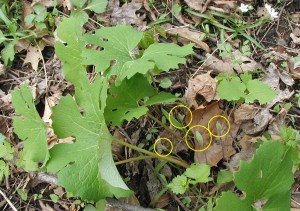
Bloodroot seedpods are circled in yellow in the image above. (Click on photo for larger image.) Eventually, the flower stem will bend down to the ground where the seedpod can release its contents. The bloodroot plant disappears, or cycles back to the earth, in summer.
(Photos of bloodroot flowers were taken 3Apr2010 and photos of bloodroot leaves were taken 18Apr2010.)
Bloodroot is named for the red juice that bleeds out from a cut or damaged root. The root itself is an orange-red color. Native Americans used bloodroot as a dye and to decorate their skin. If you rub the juice on your skin it will last a few days.
Peterson’s Medicinal Plants Guide tells us that, historically, bloodroot was used in the form of a root tea to treat coughs, laryngitis, asthma, bronchitis, lung ailments and rheumatism.
CAUTION – bloodroot is toxic – do not ingest.
A component in bloodroot, sanguinarine, has been shown to have antiseptic, anesthetic and anticancer activity. Today, it is used in commercial mouthwash and toothpastes as a plaque-inhibiting agent.
![Reblog this post [with Zemanta]](http://img.zemanta.com/reblog_e.png?x-id=68ea5c60-a1b8-4827-a7f6-8d9498ffdf09)